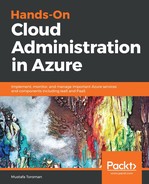There are few things you need to consider regarding pricing in Microsoft Azure. There are resources that have fixed pricing and resources that have consumption pricing. Also, fixed-price resources sometimes have service level limits included in the basic price. Once you reach that limit, you will be charged extra based on consumption. This potentially turns fixed-priced resources into consumption-priced ones. There are also exceptions that have different uses applied.
Resources that have fixed pricing will be added to your bill as soon as you create them. Fixed-pricing resources are billed on a monthly basis, have a fixed price, and are added to your bill as soon as you create them. Examples of these services would be OMS or Azure Active Directory on higher tiers. A reserved public IP address is also one of the fixed-cost resources. After you delete this type of resource, it will be added to your bill for the current billing period.
Azure storage is based on consumption and you pay for the amount of data you have in your storage account. But the amount of data varies every month and there could be less data at the beginning or end of the month, but more data in the middle of the month. In this case, average consumption is calculated and you are billed on the average consumption of Azure Storage.
An example of a service that has performance-level restrictions would be bandwidth. Inbound data transfer is free of charge and you don't pay anything as long as data is going towards an Azure data center. Outbound data is free for the first 5 GB per month and you are charged extra for everything over those 5 GB. Another example of a service limit would be Azure container registry, where you have 100 minutes of CPU included but pay extra when exceeding that limit. Azure function is also an example of this type of resource where you get the first 1,000,000 executions for free and you are charged for additional executions.
Resources based on computing are calculated on a per-minute basis. If you have a virtual machine or app service running, billing will stop as soon as you delete these resources. This also applies to resources being stopped in some cases. Azure SQL database can't be stopped but pricing will be calculated on a per-minute basis. If you delete Azure SQL database, you stop paying for it the same minute it's deleted. For virtual machines and app services, you can stop these resources and you will not pay for compute hours any longer. Note that there are a few pricing details related to a virtual machine. Virtual machine price information, that you can find in Azure portal when creating virtual machine or shown in Azure calculator, is only for compute hours. A virtual machine also uses Azure storage that you pay for, separately from computing, and you will pay for storage no matter if the virtual machine is running or stopped. Some network components can create additional charges for virtual machines. For example, you can reserve a public IP address that is charged separately.
It is very important to keep track of your resources in Azure and to know what you are using, if resources are utilized, and what the limits are for current resources. If you are not using something correctly or not using it at all, you are still paying for it. This is different from a traditional IT environment where you have resources prepaid and it doesn't really matter if a single virtual machine is being used or not as long as you don't reach the resource limit at the host level. In Azure, you are paying for everything you created (or have running in some cases) so you need to keep track of active resources and what you actually need. Otherwise, the cloud can become a very expensive solution and bills will start to pile up. Financial benefits can be great but if you are not careful, it can go the other way as well. I've seen many companies using a development and test environment without control and many resources where no one knows who created them and why, let alone if there is someone actually using them. This is not as often a problem with production environments, but can happen in some cases.
Be smart and Azure will help you, but if you don't keep track of usage and billing, it can go the other way. It's your choice: you can get either promoted or fired!
